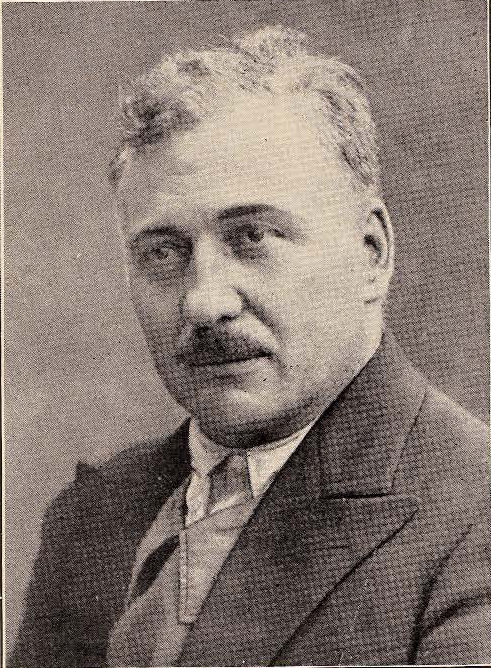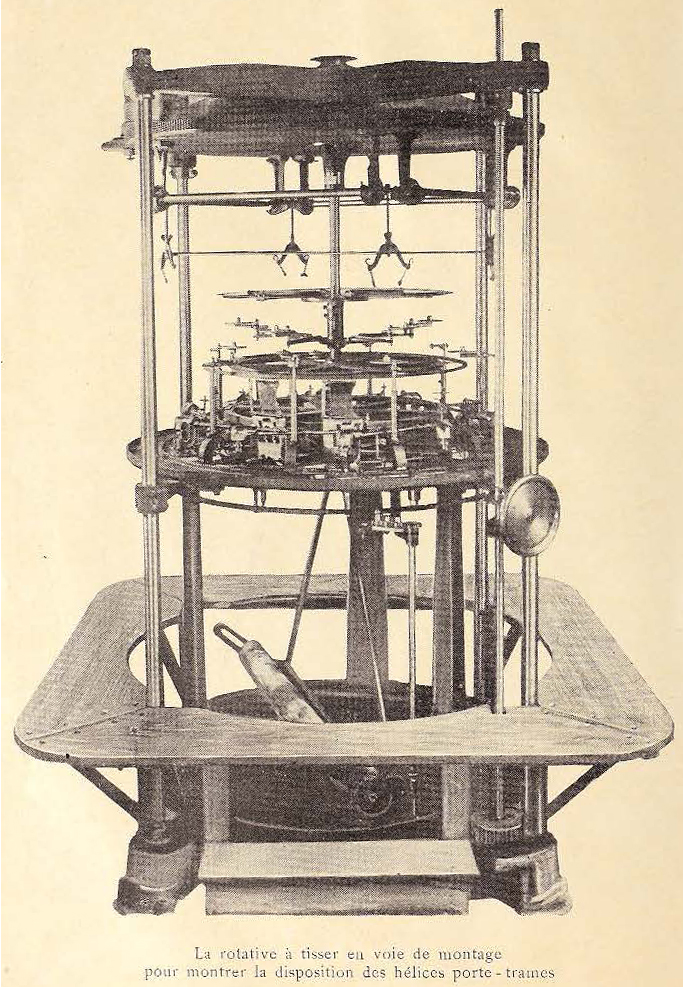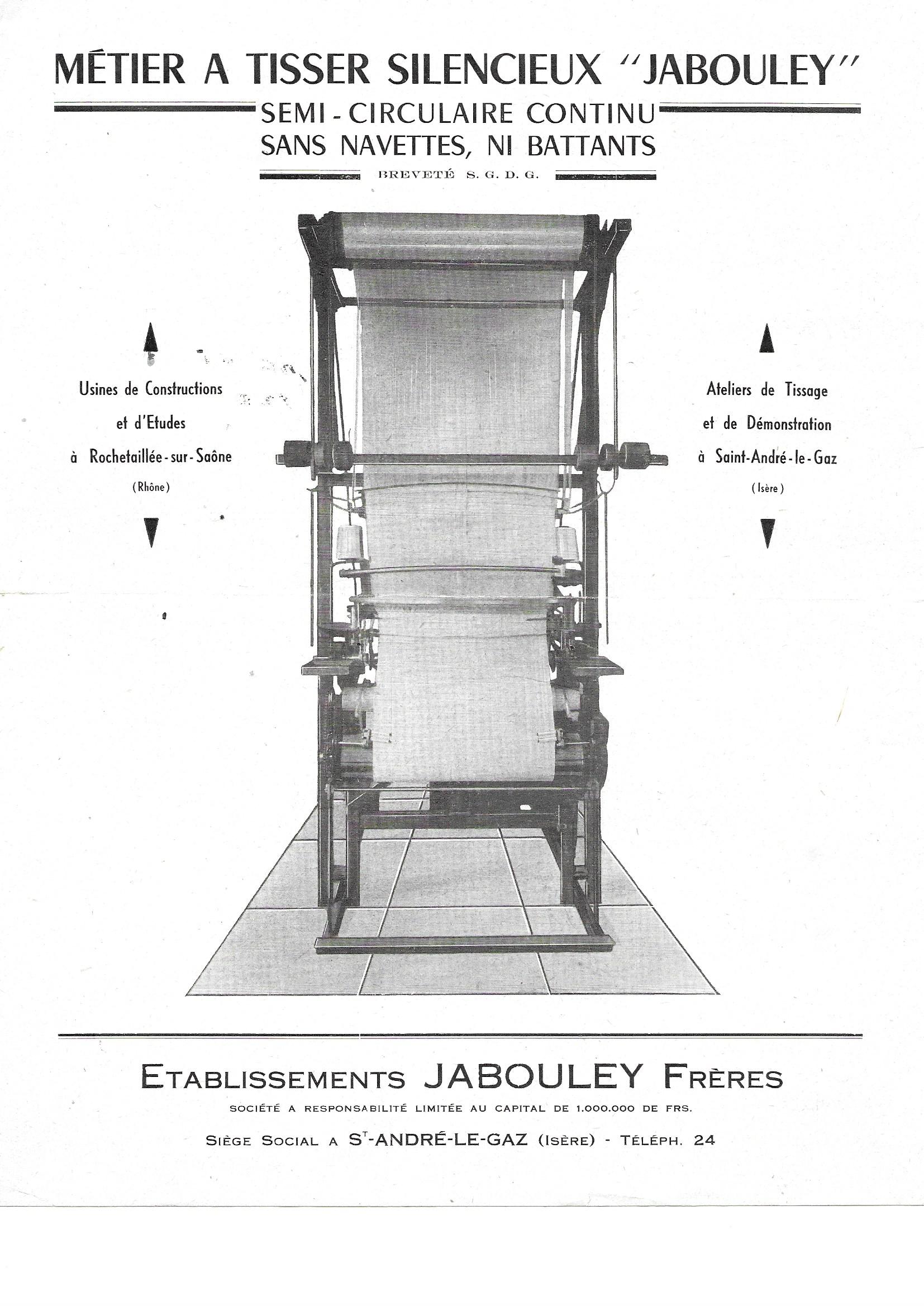Joanny Barthélemy Jabouley
Joanny Barthélemy Jabouley is a French mechanic born in 1884 in Villeurbanne and inventor in 1928 of the first circular loom. He died in Lyon in 1965.
Biography
 |
|
Joanny Jabouley |
Born on September 29, 1884 in Lyon, Midi Street (renamed Dedieu street) Charpennes district, grandson of a weaver inventor of a planet to shape velvet, son of a master tulist, he left school at twelve before his certificate of studies to become a textile mechanic, first as an apprentice at Johnson, builder of looms at the Charpennes. After five years of military service in the navy in Toulon, starting in 1904, he returned in 1909 to work with his brother Francis and his father Barthélemy Serve in the family workshop. He married Jeanne Marie Lavy on July 17th,1909 in Villeurbanne. They had four children (André, Germaine, Georges, Lucien). On the death of his parents, the workshop modernized under the name of Jabouley Brothers and became more prosperous. The First World War took him away from his studio for four years. But the postwar period brought about profound changes in clothing. Ruined by the significant decline in the demand for tulle in clothing, Joanny Jabouley lost his workshop found himself without resources, while his brother Francis Jabouley went alone into other productions that became the Dentelles Jabouley in Saint-André-le-Gaz (Isère). He died on 9 March 1965 in Lyon, France.
 |
|
Joanny Jabouley and Préfet Henri Longchambon (right) |
It was by trying to construct a model of a loom for his eldest son, André, that came to him the idea of designing a craft allowing to put more than one frame at a time, which would allow an enormous gain of productivity. After several years of prototyping, and despite the skepticism surrounding him, he developed a rotary weaving machine with a rotating chain and helices. He succeeded in doing so in 1923. A year of additional work and the establishment of a "continuous loom company, Joanny Jabouley system" enabled him to design a new craft to lay six frames at a time. This prototype seduced the three Diederichs brothers, loom builders in Sainte-Colombe-les-Vienne. The machine was exhibited in 1927 at the Lyon Fair. The Chamber of Commerce of Lyons, however, only granted him a silver medal. It was also presented in Leipzig, Germany.
The first large craft of this type (3.4m in circumference) made it possible to obtain a better quality fabric at a speed of 240m of frame per minute, that is to say much higher than that of the conventional looms of the 'time. The circular comb of the loom is an endless comb, enabling, with rollers pushing the threads in one direction or the other, to realize the movement of taffeta. The key to the mechanism of Joanny Jabouley lies in the immobilization of the shuttles and in the rotation of the chain around them. The unwinding of the weft is effected by a needle rotating about the axis of the thread carrying spool, thus maintaining a constantly equal tension.
 |
|
Le métier à tisser rotatif de Joanny Jabouley |
Advantages: smaller footprint, wider weaving, speed, reduced downtime, a single operator can operate several looms, ease to change for very different items, adapt to obtain fabrics that are not executable on the traditional looms.
Not finding in France an industrialist able and willing to pursue the development of the machine, he left around 1933 with his family to work in England, Spondon, next to Derby, and registered with Robert Yeadon a patent in 1935 with the US Patent Office. Robert Yeadon subsequently pursued development with Frank Corbyn Hale (US Patents US2101022A and US2080819A of 1937).
Back in France around 1935, he settled in Rochetaillée-sur-Saône.
Joanny Jabouley s'intéressa également à la mise au point de métiers à tisser silencieux, semi-circulaires et continu, sans navettes, ni battants (breveté S.G.D.G.).
|
|
|
Jabouley Looms Documentation |
The commercial documentation indicated:
Operating economy
With equal production, and on one side only, our new loom saves 80% of labor
cost over the fastest inline loom. Semi rotary, very simple mechanically and
using a relatively slow movement, it does not cause any wear, eliminates the
down time and considerably reduces the costs of power (1/4 horse).
Capital saving
Thanks to its sale price, it achieves a significant saving of the capital employed (double
loom).
Dimensions
Two looms are assembled to reduce work space; this allows the following dimensions for the two twinned and independent
looms: Length 2.50m, Width 1.50m, Height 2.80.
Main Features
Our first series of looms for taffeta movements is made without a comb-beating and without a shuttle, the material therefore undergoes no friction and no fatigue, which
allows for almost no breakage. No more shuttles, no more stops for frame changes, this one being
outside, the tightening of the weft, progressive and mechanical, gives an embuvage, a flexibility and a grain to the fabric which one cannot obtain on the current
looms.
We will then build looms to weave twill, and with independent weft movements, allowing the weaving of Scottish
fabrics with a large number of colors.
|
|
|
Patents United States Patent Office : Canadian Intellectual Property Office : |
|
|
|
|
Bibliography et Sources "Mr. JABOULEY (from Rochetaillée-sur-Saône) has developed a WEAVING TRIM WITHOUT SWING OR SHUTTLE ... and which works without any
noise", "A new era is opening up for weaving: I saw the first silent and shuttle-free weaving machine rolling in. Following Jacquard, the name of Joanny Jabouley will soon be known around the
world, from our special correspondent on May 16th at Rochetaillée, "Historical turn in the textile: The Lyonnais JABOULEY realizes in
Fontaines-sur-Saône, the first silent looms" "THistorical turn in the textile: The
Lyonner JABOULEY builds in Fontaines-sur-Saône the first silent
looms. In a few days, they will work in St-André-le-Gaz". "About the circular loom, the invention of Joanny Jabouley," "The Jabouley-Diederichs weaving
loom" "A new Jacquard" "The new rotary loom of Lyon mechanic Joanny Jabouley" |
|
|
|
|
| Musée Historique des Tissus et des Arts Décoratifs de Lyon - 34 rue de la Charité - F-69002 Lyon, France - www.museedestissus.fr | |
If you have any additional information on the life and work of Joanny Barthélemy Jabouley, please contact us at the address below to enrich this page.
![]()
Last update : 20200510 12:00
GoyPedia

